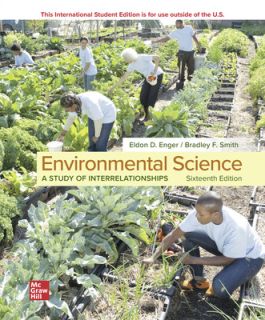Environmental Science ISE
1264990979
·
9781264990979
Environmental Science: A Study of Interrelationships is a full-color, introductory environmental science text that is known for being concise, conceptual, and value-priced. The approach and reading level cover the basic concepts without overloading s…
Read More
After purchasing your eBook, login to the McGraw Hill Bookshelf website and redeem the access code from your order confirmation email.
- Access your eBook online or offline
- Easily highlight and take notes
- Fully searchable content
- Syncs across platforms
NOTE: eBook purchase does not include Connect homework or adaptive SmartBook assignments
Chapter 1 Environmental InterrelationshipsChapter 2 Environmental EthicsChapter 3 Risk, Economics, and Environmental Concerns Chapter 4 Interrelated Scientific Principles: Matter, Energy, and EnvironmentChapter 5 Interactions: Environments and OrganismsChapter 6 Kinds of Ecosystems and CommunitiesChapter 7 Populations: Characteristics and IssuesChapter 8 Energy and Civilization: Patterns of ConsumptionChapter 9 Nonrenewable Energy SourcesChapter 10 Renewable Energy SourcesChapter 11 Biodiversity IssuesChapter 12 Land-Use PlanningChapter 13 Soil and Its UsesChapter 14 Agricultural Methods and Pest ManagementChapter 15 Water ManagementChapter 16 Air Quality IssuesChapter 17 Climate Change: A Twenty-first Century Issue Chapter 18 Solid Waste Management and Disposal Chapter 19 Environmental Regulations: Hazardous Substances and Wastes Chapter 20 Environmental Policy and Decision Making
Chapter 3 Risk, Economics, and Environmental Concerns Chapter 4 Interrelated Scientific Principles: Matter, Energy, and EnvironmentChapter 5 Interactions: Environments and OrganismsChapter 6 Kinds of Ecosystems and CommunitiesChapter 7 Populations: Characteristics and IssuesChapter 8 Energy and Civilization: Patterns of ConsumptionChapter 9 Nonrenewable Energy SourcesChapter 10 Renewable Energy SourcesChapter 11 Biodiversity IssuesChapter 12 Land-Use PlanningChapter 13 Soil and Its UsesChapter 14 Agricultural Methods and Pest ManagementChapter 15 Water ManagementChapter 16 Air Quality IssuesChapter 17 Climate Change: A Twenty-first Century Issue Chapter 18 Solid Waste Management and Disposal Chapter 19 Environmental Regulations: Hazardous Substances and Wastes Chapter 20 Environmental Policy and Decision Making
Chapter 5 Interactions: Environments and OrganismsChapter 6 Kinds of Ecosystems and CommunitiesChapter 7 Populations: Characteristics and IssuesChapter 8 Energy and Civilization: Patterns of ConsumptionChapter 9 Nonrenewable Energy SourcesChapter 10 Renewable Energy SourcesChapter 11 Biodiversity IssuesChapter 12 Land-Use PlanningChapter 13 Soil and Its UsesChapter 14 Agricultural Methods and Pest ManagementChapter 15 Water ManagementChapter 16 Air Quality IssuesChapter 17 Climate Change: A Twenty-first Century Issue Chapter 18 Solid Waste Management and Disposal Chapter 19 Environmental Regulations: Hazardous Substances and Wastes Chapter 20 Environmental Policy and Decision Making
Chapter 7 Populations: Characteristics and IssuesChapter 8 Energy and Civilization: Patterns of ConsumptionChapter 9 Nonrenewable Energy SourcesChapter 10 Renewable Energy SourcesChapter 11 Biodiversity IssuesChapter 12 Land-Use PlanningChapter 13 Soil and Its UsesChapter 14 Agricultural Methods and Pest ManagementChapter 15 Water ManagementChapter 16 Air Quality IssuesChapter 17 Climate Change: A Twenty-first Century Issue Chapter 18 Solid Waste Management and Disposal Chapter 19 Environmental Regulations: Hazardous Substances and Wastes Chapter 20 Environmental Policy and Decision Making
Chapter 9 Nonrenewable Energy SourcesChapter 10 Renewable Energy SourcesChapter 11 Biodiversity IssuesChapter 12 Land-Use PlanningChapter 13 Soil and Its UsesChapter 14 Agricultural Methods and Pest ManagementChapter 15 Water ManagementChapter 16 Air Quality IssuesChapter 17 Climate Change: A Twenty-first Century Issue Chapter 18 Solid Waste Management and Disposal Chapter 19 Environmental Regulations: Hazardous Substances and Wastes Chapter 20 Environmental Policy and Decision Making
Chapter 11 Biodiversity IssuesChapter 12 Land-Use PlanningChapter 13 Soil and Its UsesChapter 14 Agricultural Methods and Pest ManagementChapter 15 Water ManagementChapter 16 Air Quality IssuesChapter 17 Climate Change: A Twenty-first Century Issue Chapter 18 Solid Waste Management and Disposal Chapter 19 Environmental Regulations: Hazardous Substances and Wastes Chapter 20 Environmental Policy and Decision Making
Chapter 13 Soil and Its UsesChapter 14 Agricultural Methods and Pest ManagementChapter 15 Water ManagementChapter 16 Air Quality IssuesChapter 17 Climate Change: A Twenty-first Century Issue Chapter 18 Solid Waste Management and Disposal Chapter 19 Environmental Regulations: Hazardous Substances and Wastes Chapter 20 Environmental Policy and Decision Making
Chapter 15 Water ManagementChapter 16 Air Quality IssuesChapter 17 Climate Change: A Twenty-first Century Issue Chapter 18 Solid Waste Management and Disposal Chapter 19 Environmental Regulations: Hazardous Substances and Wastes Chapter 20 Environmental Policy and Decision Making
Chapter 17 Climate Change: A Twenty-first Century Issue Chapter 18 Solid Waste Management and Disposal Chapter 19 Environmental Regulations: Hazardous Substances and Wastes Chapter 20 Environmental Policy and Decision Making
Chapter 19 Environmental Regulations: Hazardous Substances and Wastes Chapter 20 Environmental Policy and Decision Making
Environmental Science: A Study of Interrelationships is a full-color, introductory environmental science text that is known for being concise, conceptual, and value-priced. The approach and reading level cover the basic concepts without overloading students with too much detail. The authors reinforce the text's central theme of "interrelationships" by providing a historical perspective, information on economic and political realities, discuss the role of different social experiences, and integrate this with the crucial science to describe the natural world and how we affect it.

